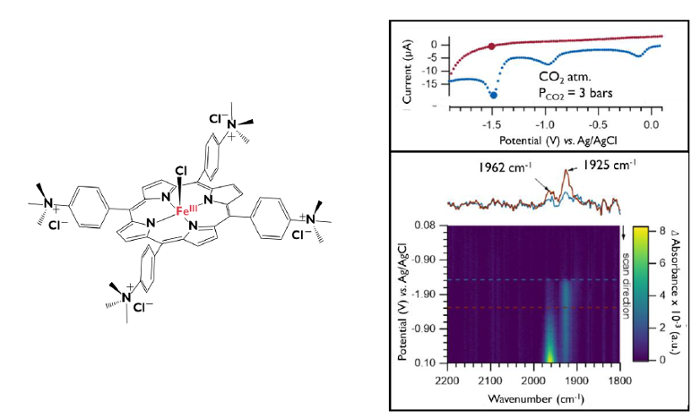Lecture
Van Marum Colloquium: Unraveling the mechanism of CO2 catalytic reduction by an iron porphyrin through spectroelectrochemical analysis
- Aude Salamé (LEM, Université Paris Cité)
- Date
- Tuesday 19 March 2024
- Time
- Location
-
Gorlaeus Building
Einsteinweg 55
2333 CC Leiden - Room
- CE.0.18
Abstract
The study of electrochemical reduction of carbon dioxide (CO2) to carbon monoxide (CO) and other C1 products provides efficient ways to control the CO2 reduction reaction (CO2RR) and to further develop the production of fuels and chemical feedstocks. Molecular catalysts made of earth-abundant metals are the focal point of attention at the Laboratoire d'Electrochimie Moléculaire (LEM) for achieving these goals. Decades of electrochemical research have proven iron porphyrins to be excellent homogeneous catalysts for the electroreduction of CO2 to CO.[1] Among them, [Fe(pTMA)Cl]Cl4 is one of the most efficient catalyst (Fig.1, left). [2],[3] Despite the advances that electrochemistry has made in understanding the mechanistic aspects of this catalytic reduction of CO2 by Fe porphyrins, the lack of spectroscopic signatures prevents us from defining the structures of intermediates along the catalytic cycle. Spectroelectrochemistry (SEC), the coupling of spectroscopy and electrochemistry, is a powerful tool to elucidate this mechanism. [4]
Our most recent results obtained in closed collaboration with Uppsala University will be presented in this seminar. The combination of infrared and UV-visible SEC that we utilized has enabled us to successfully detect FeX-CO intermediates (where X relates to the oxidation state of the catalyst), which is illustrated in (Fig. 1, right). The integration of infrared and UV-visible SEC has proven to be immensely valuable for our research. The two infrared bands that appear in this figure correspond to the C=O stretching vibrations observed during the process of CO2 catalytic reduction to CO. The precise assignment of these bands can be enabled through thorough exploration with comparable experiments under CO atmosphere, allowing a detailed catalytic cycle to be established.

